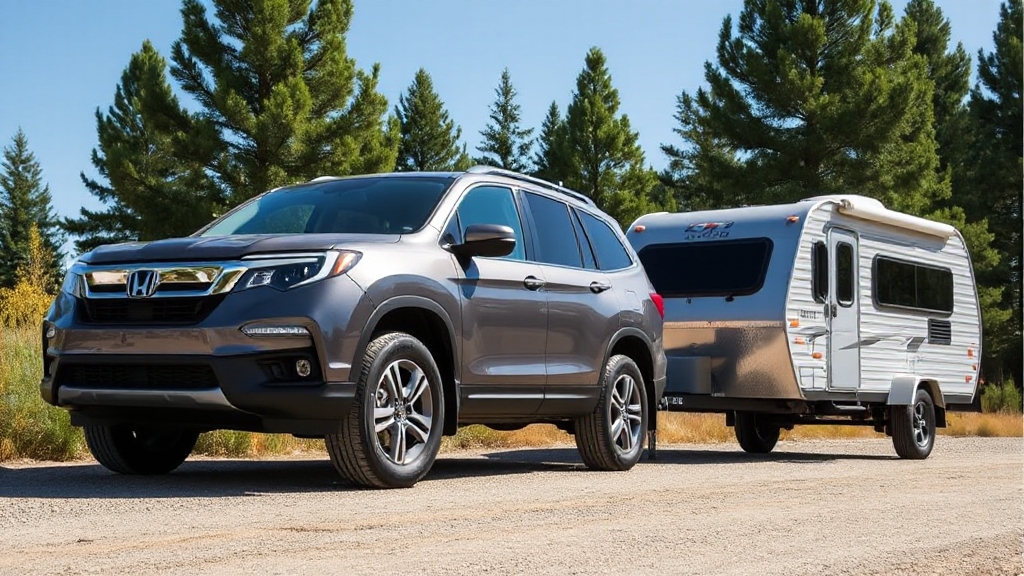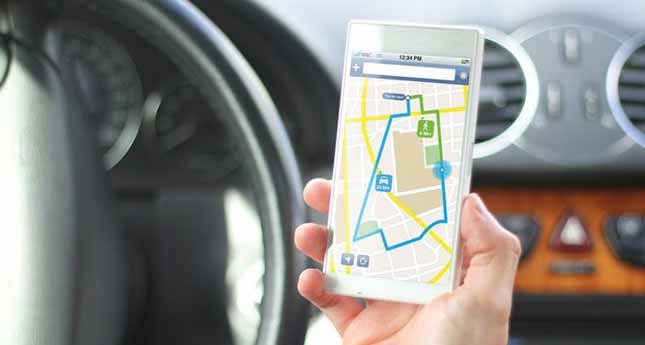Last Updated on June 11, 2025
You can tow a camper with a Honda Pilot, especially if you have the AWD model, which handles up to 5,000 pounds, suitable for campers around 24 feet long.
The 3.5L V6 engine combined with AWD and Tow mode optimizes performance and stability. While 2WD models tow less about 3,500 pounds they still manage lighter campers safely.
Proper hitching, safety gear, and vehicle maintenance are essential. Learn how engine options, safety features, and yearly changes influence your towing setup.
Key Takeaways
- Honda Pilot AWD models can tow up to 5,000 pounds, suitable for campers up to approximately 24 feet in length.
- 2WD Honda Pilots have a towing capacity of 3,500 pounds, ideal for lighter, smaller campers.
- Proper equipment like trailer hitches, wiring harnesses, and brake controllers are essential for safe towing.
- Honda Pilot’s safety features include Trailer Stability Control and Tow mode to enhance towing stability and control.
- Maintaining correct load distribution, tire pressure, and using weight distribution hitches ensures safe camper towing.
Honda Pilot’s Towing Capacity
When you need to tow a camper or trailer, understanding the Honda Pilot’s towing capacity is crucial to guarantee safety and performance. The Pilot can tow up to 5,000 pounds with all-wheel drive (AWD) and 3,500 pounds with two-wheel drive (2WD).
This makes it suitable for hauling small trailers, Jet Skis, ATVs, and pop-up campers. Equipped properly, it can handle campers up to 24 feet in length. Using the correct license plate size for your camper is important to comply with regulations while towing.
All trims feature a Tow drive mode that enhances towing performance, and premium unleaded fuel is recommended when towing. Towing capacity varies by trim and drivetrain, so you should verify your model’s specifications.
Proper load distribution and adherence to manufacturer guidelines are essential to maintain safety and optimize the vehicle’s towing capabilities. The TrailSport trim includes a standard trailer hitch receiver and rear recovery point, adding convenience for towing needs.
Engine and Drivetrain Impact on Towing
When towing with your Honda Pilot, the 3.5-liter V6 engine delivers 285 horsepower and 262 lb-ft of torque, providing the power needed for moderate loads. Ensuring your vehicle has a high Cold Cranking Amps rating battery can improve starting reliability when towing heavy campers.
You’ll find that the AWD models, equipped with the i-VTM4 system and Tow mode, offer enhanced traction and control compared to 2WD versions. Understanding how these engine and drivetrain features interact helps you maximize towing efficiency and safety.
Additionally, the AWD trims have a maximum towing capacity of up to 5,000 pounds, making them suitable for pulling larger campers when equipped with proper towing accessories.
Engine Power Influence
Although towing demands considerable power and control, the Honda Pilot’s V6 engine delivers 285 horsepower and robust torque, providing the strength needed to manage heavy loads efficiently.
Its smooth-shifting transmission ensures consistent power delivery, while premium unleaded fuel optimizes performance. This engine balances power and efficiency, maintaining fuel economy even when towing near its 5,000-pound capacity (with AWD).
Proper stability features are essential when towing to ensure safety and control on the road. The maximum towing capacity varies by model and drivetrain, requiring proper equipment to reach the maximum towing limits. Features like Tow mode further enhance engine response for towing tasks.
| Feature | Specification | Benefit |
|---|---|---|
| Horsepower | 285 hp | Provides strong acceleration |
| Torque | Robust (Exact value varies) | Manages heavy towing loads |
| Transmission | Smooth-shifting automatic | Maintains consistent power |
Drivetrain Types Comparison
Since towing demands both power and control, choosing the right drivetrain considerably affects your Honda Pilot’s towing performance. The 2WD drivetrain supports towing up to 3,500 pounds, suitable for lighter campers. Using tires with the proper load capacity is essential to ensure safe towing with any drivetrain.
The AWD drivetrain boosts capacity to 5,000 pounds, thanks to better torque distribution. This improved traction enhances stability, especially on uneven or slippery terrain.
The i-VTM4 system further refines torque management, optimizing control during towing. Your Pilot’s V6 engine, delivering 285 horsepower and 262 lb-ft of torque, pairs with a 10-speed automatic transmission to maximize towing efficiency.
Additionally, the availability of Drive Modes such as Tow mode allows drivers to customize vehicle settings to further enhance towing performance. AWD’s traction control helps maintain stability under load, reducing slippage risks.
When towing a camper, opting for AWD markedly increases your vehicle’s capability and safety, ensuring better handling and confidence on the road.
Two-Mode Benefits
Because towing places extra demands on your Honda Pilot’s engine and drivetrain, activating Tow Mode considerably enhances their performance and durability. Tow Mode optimizes the V-6’s 285 horsepower and 262 lb-ft torque, managing power to reduce engine strain during acceleration and hill climbs.
It keeps RPMs in the ideal range, minimizing unnecessary shifts and engine wear. Proper use of Tow Mode can also contribute to extending the lifespan of critical components by reducing excessive wear.
The drivetrain’s i-VTM4 AWD system improves traction by distributing torque efficiently, reducing wheel spin and enhancing stability with heavy loads. The 10-speed transmission adjusts shift points for smoother gear changes and engages additional cooling to handle thermal stress.
The Pilot’s towing capacity varies by drivetrain, with AWD trims offering up to 5,000 lbs, making it suitable for light to moderate camper towing. Tow Mode also activates suspension reinforcements and trailer sway control to maintain safe handling.
Together, these features help you tow campers confidently while preserving your Pilot’s mechanical integrity. Using proper stabilization equipment during towing ensures safer and more stable handling in various road conditions.
Camper Length Limits for the Honda Pilot
When towing a camper with your Honda Pilot, keep the camper length within recommended limits to make certain of safe handling and performance. Generally, the maximum camper length you should tow is 24 feet. Staying within this limit helps maintain vehicle control and stability on the road.
Additionally, considering a battery with maintenance-free features can ease power management during your trip. To guarantee you’re within safe parameters, consider these three key points:
- Confirm your camper’s length doesn’t exceed 24 feet to stay within the Pilot’s towing design.
- Make sure the camper’s weight is under 5,000 pounds, which aligns with the Pilot’s maximum towing capacity.
- Use a compatible trailer hitch and wiring harness to ensure proper connection and control.
The 2024 Honda Pilot offers a towing capacity of up to 5,000 pounds, making it well-suited for a variety of camper sizes. Following these guidelines will help you tow safely and effectively with your Honda Pilot.
Towing Features Available Across Trims
Although towing capabilities vary across trims, the Honda Pilot offers a range of features designed to enhance your towing experience. Every trim comes with a 3.5-liter V6 engine and a 10-speed automatic transmission.
Additionally, the available 5-mode drive system adjusts the vehicle’s performance to suit different driving conditions, including towing. You’ll find front-wheel drive standard on Sport, EX-L, and Touring trims, with all-wheel drive optional.
AWD is standard on TrailSport, Elite, and Black Edition trims, boosting towing capacity from 3,500 to 5,000 pounds. For those towing with RVs, it’s important to consider surge protector options to safeguard your electrical appliances.
All trims include Honda Sensing safety tech, braking assist, and stability control for towing stability. AWD models add selectable drive modes, including Tow mode, optimizing traction and performance.
TrailSport stands out with enhanced suspension and skid plates for off-road towing. Plus, every trim features a standard trailer wiring harness, with tow hitches available factory or dealer-installed.
Yearly Variations in Towing Capacity
As you explore the Honda Pilot’s towing capabilities, you’ll notice that its maximum towing capacity has changed remarkably over the years. These yearly variations notably affect what size camper you can tow comfortably and safely.
- From 2003 to 2015, 4WD models generally towed up to 4,500 lbs, while 2WD models ranged from 2,000 to 3,500 lbs depending on equipment like ATF coolers. Additionally, passenger count significantly impacts towing capacity, with 8 passengers often meaning no towing is recommended. Proper towing maintenance can also help ensure safe and efficient towing performance.
- Starting in 2016, AWD models increased towing capacity to 5,000 lbs, offering more flexibility for heavier campers.
- Full passenger loads reduce towing capacity substantially, so you should account for passenger weight when planning your tow.
Safety Considerations When Towing a Camper
When towing a camper with your Honda Pilot, you need to pay close attention to trailer stability control to prevent sway and maintain safe handling. Proper weight distribution is essential to keep the load balanced and reduce strain on your vehicle’s suspension and brakes.
Additionally, ensuring your brake system is efficient helps you stop smoothly and avoid dangerous situations on the road. Have the factory-installed towing package, which includes a trailer hitch and wiring harness, to safely achieve the maximum towing capacity.
Using wheel bearing grease with excellent water resistance and load-bearing capacity can help maintain safe trailer operation and prevent bearing failure during towing.
Trailer Stability Control
Since towing a camper can introduce unpredictable forces like crosswinds and sudden maneuvers, the Honda Pilot’s Trailer Stability Control system actively works to maintain your control. This system uses the Vehicle Stability Assist (VSA) to detect and correct trailer sway, enhancing towing safety.
When it activates, the VSA indicator blinks, signaling that the system is stabilizing your trailer. Here’s how Trailer Stability Control helps you:
- It applies selective braking to counteract trailer sway caused by crosswinds or abrupt steering.
- It adjusts engine power to improve overall towing stability.
- It integrates with other towing features in the Pilot’s towing package to provide a smooth, controlled towing experience. For even greater control, some drivers complement this system with an anti-sway trailer hitch to further reduce lateral trailer movement.
While Trailer Stability Control helps mitigate sway, remember that it does not prevent sway and maintaining safe towing practices is essential. This technology is essential for safely handling your camper in varying conditions.
Weight Distribution Importance
Although towing a camper involves many factors, ensuring proper weight distribution stands out as a critical safety consideration. You need to balance the camper’s load carefully to maintain trailer stability and control.
Improper weight distribution can cause trailer sway, increasing the risk of losing control, especially at higher speeds or on uneven roads. Use appropriate towing equipment designed to help distribute weight evenly, and always follow the manufacturer’s guidelines for maximum tongue weight and cargo placement.
Regularly check the setup during your trip to make sure weight distribution remains ideal. Utilizing the Honda Pilot’s payload capacity up to 1,625 lbs ensures you do not overload the vehicle beyond safe limits.
This approach not only enhances your Honda Pilot’s towing performance but also promotes safer handling, reducing stress on your vehicle and improving overall towing safety.
Brake System Efficiency
Balancing the weight of your camper sets the foundation for safe towing, but your Honda Pilot’s brake system plays an equally important role in maintaining control on the road.
The Pilot’s all-wheel disc brakes, enhanced by ABS and electronic brake distribution, offer reliable stopping power even under load. To maximize brake efficiency and safety while towing, consider these key points:
- Ensure proper load distribution to promote even brake wear and consistent stopping performance.
- Utilize the available towing package, which optimizes trailer hitch setup and brake system responsiveness.
- Maintain your brakes regularly—check pads, rotors, and fluid—to prevent overheating and guarantee stability during braking.
Additionally, the Pilot’s towing package includes safety features like Hill Descent Control that assist in maintaining control on steep or uneven terrain. Together, these elements help the Pilot maintain traction, stability, and control, essential for towing your camper safely.
Towing Accessories and Equipment Needed
Before you hitch up your camper to the Honda Pilot, you’ll need the right towing accessories and equipment to guarantee safety and performance.
A factory-installed trailer hitch and wiring harness are essential for safe connections, while safety systems like Vehicle Stability Assist enhance control. The available tow package and Tow drive mode optimize towing efficiency.
Verify that the trailer’s weight does not exceed the Pilot’s maximum towing capacity of 5,000 pounds to avoid safety risks.
| Accessory | Purpose |
|---|---|
| Ball Mounts | Attach trailer securely to hitch |
| Tow Straps | Backup securing method in emergencies |
| Breakaway Switch | Activates trailer brakes if detached |
Additionally, tire pressure monitoring and tie-downs ensure secure, safe towing. Proper equipment and regular maintenance are crucial for handling campers within the Pilot’s 5,000-pound capacity.
Comparing AWD and 2WD for Camper Towing
When deciding between AWD and 2WD for towing your camper with a Honda Pilot, understanding their differences in capacity and performance is essential. AWD models handle up to 5,000 lbs thanks to superior torque distribution and traction, while 2WD versions max out at 3,500 lbs.
Here’s what you should consider:
- Towing Capacity: AWD offers higher limits, ideal for larger campers; 2WD suits lighter trailers.
- Traction and Stability: AWD’s i-VTM4 system improves grip and reduces sway, especially on slippery terrain; 2WD is more prone to wheel slip near max loads. The Pilot’s Hill Start Assist feature also helps prevent rollback on inclines, enhancing towing safety.
- Equipment Needs: AWD requires less aftermarket gear for heavy towing, whereas 2WD may need upgraded tires or suspension for safety.
Tips for Enhancing Your Honda Pilot’s Towing Experience
Understanding the differences between AWD and 2WD towing capacities sets the stage for maximizing your Honda Pilot’s performance on the road. Equip your vehicle with a factory-installed tow package, including a trailer hitch and upgraded cooling system, to handle the load efficiently.
Use a weight distribution hitch and trailer brake controller for stability and safety. Optimize performance by selecting Tow mode, maintaining proper tire pressure, and regularly checking engine fluids.
Prioritize safety by staying within your Pilot’s towing limits 3,500 lbs for 2WD and 5,000 lbs for AWD and using vehicle safety systems like Trailer Stability Assist.
Plan your route carefully, verify your load weight, and ensure all trailer lights and brakes function correctly. These steps enhance your towing experience, ensuring control, comfort, and safety on every trip.
Frequently Asked Questions
How Does Towing Affect Honda Pilot’S Fuel Efficiency?
Towing reduces your Honda Pilot’s fuel efficiency by about 10-20% due to added weight and increased aerodynamic drag. You’ll notice higher fuel consumption, especially when towing near its 5,000-pound capacity.
Using the Tow drive mode helps optimize engine performance, but expect lower miles per gallon compared to normal driving. Maintaining moderate speeds and proper weight distribution also minimizes fuel loss, keeping your Pilot’s towing experience efficient and safe.
What Maintenance Is Required After Towing a Camper?
After towing, don’t let maintenance fall through the cracks. Check your engine oil and transmission fluid for proper levels and signs of stress. Inspect brakes thoroughly, including pads, rotors, and brake fluid.
Examine tires and suspension components for wear or damage, ensuring tire pressure is spot on. Test all lights and trailer wiring. Finally, inspect the hitch, safety chains, and electrical systems to keep your vehicle safe and reliable for the road ahead.
Can the Honda Pilot Tow on Steep Mountain Roads?
You can tow on steep mountain roads with your Honda Pilot, especially if it’s equipped with the i-VTM4 AWD system, which improves traction on challenging terrain. Use Tow drive mode to maintain control, reduce speed, and select the correct gear for managing inclines safely.
Just make sure your Pilot is well-maintained, and always secure your trailer properly. These steps will help guarantee safe and efficient towing on steep, mountainous routes.
Are There Restrictions for Towing Campers in Certain States?
Yes, some states have restrictions on towing campers. You’ll face size and weight limits that vary by state, like California’s highway trailer regulations or Florida’s permits for larger trailers. Texas enforces specific towing requirements too.
Additionally, local ordinances might limit towing in certain areas. Always verify state and local regulations before you tow to avoid fines and ensure safety. Special permits may be needed for oversized or heavy loads.
How Does Cargo Load Inside the Pilot Impact Towing Stability?
Cargo load inside your Pilot shifts its center of gravity, and that shift affects towing stability. When you pile on weight, you push the rear down, which can reduce steering effectiveness and front traction.
This imbalance increases trailer sway and can cause earlier activation of stability control. Plus, heavy cargo reduces braking performance and adds to tongue weight.
How Much Can a Honda Pilot Tow? Breaking Down the Numbers
If you think your Honda Pilot can tow just any camper without a second thought, think again it’s not a superhero SUV. While it handles moderate campers well, pushing beyond its towing limits risks safety and performance.
You’ve got to respect the specs, use the right gear, and choose the right trim. With proper preparation, your Pilot can make camper towing smooth, but don’t expect it to haul a small house on wheels without breaking a sweat.



